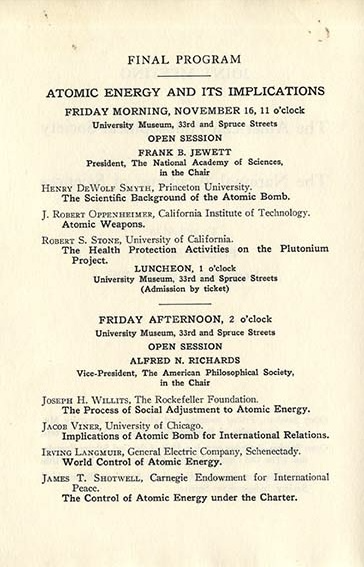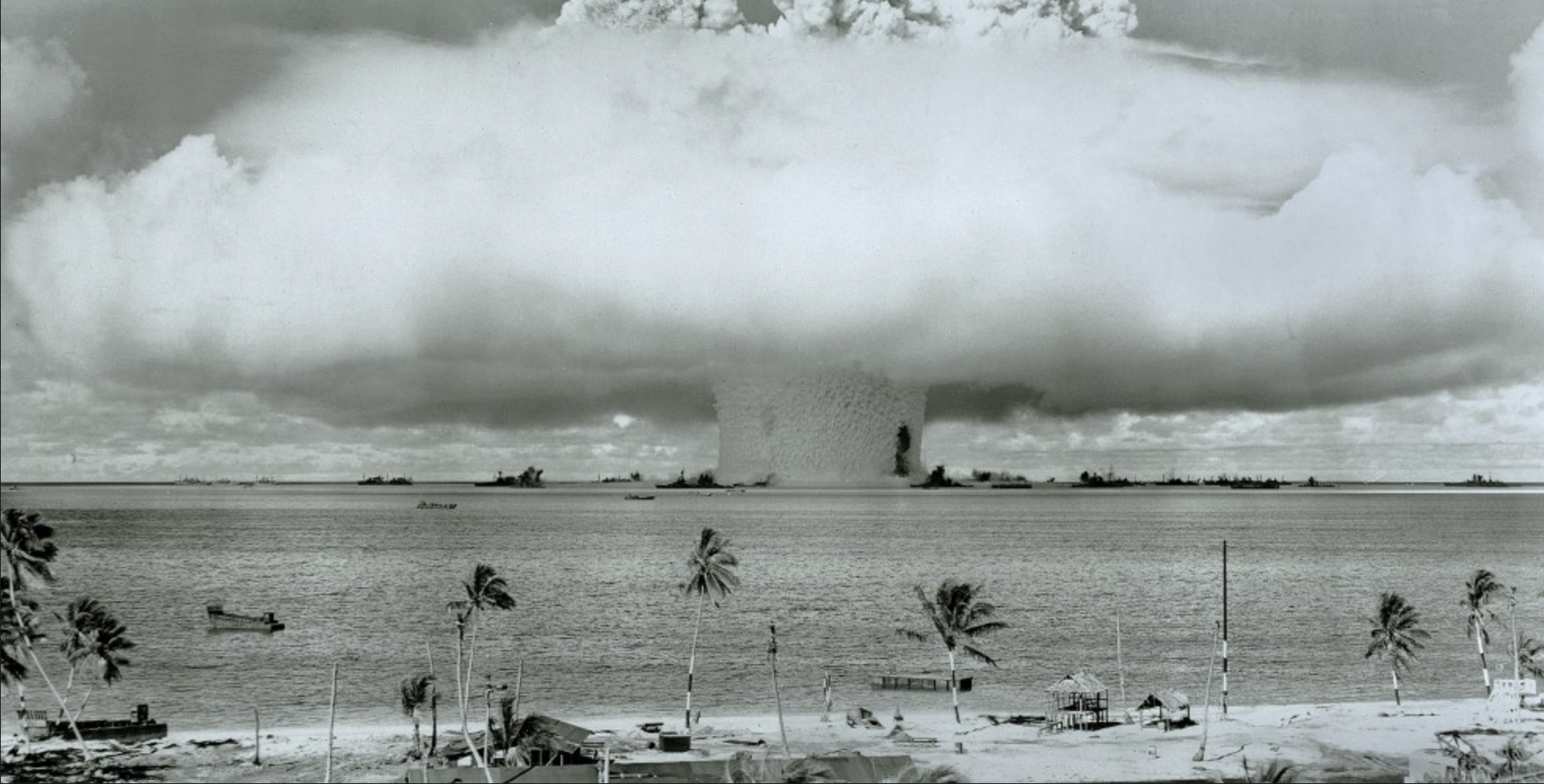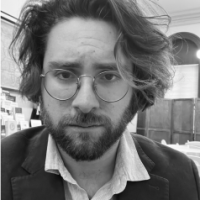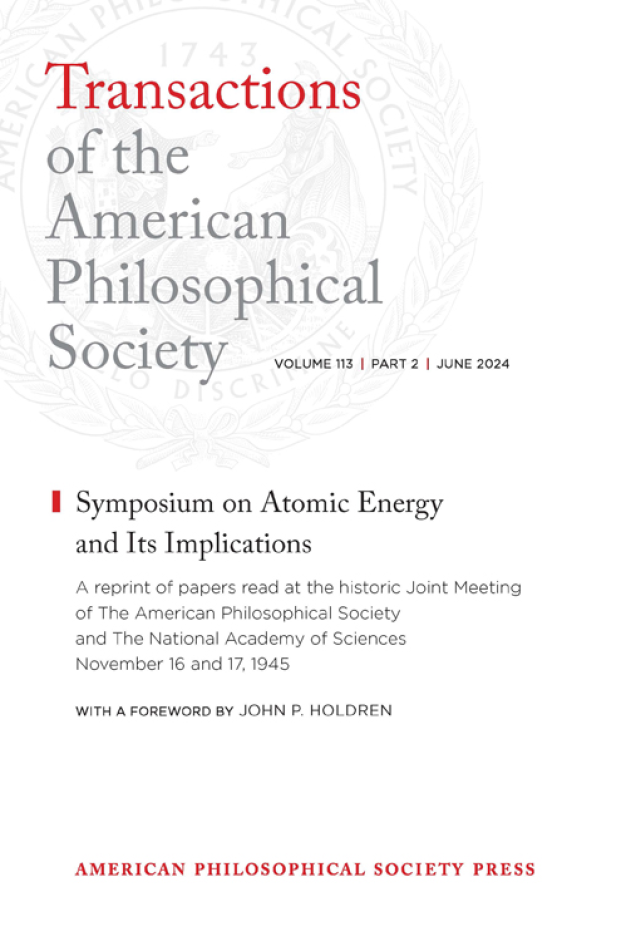“If They Are Ever Used Again…”: The 1945 Atomic Energy Symposium, with a New Introduction by John P. Holdren
On November 16th and 17th of 1945, a little over three months after the bombings of Hiroshima and Nagasaki, the American Philosophical Society and the National Academy of Sciences held a joint symposium on the science and implications of atomic weapons. The event placed physicists from Los Alamos (including J. Robert Oppenheimer, Enrico Fermi, and John Wheeler) in conversation with leading social scientists (including the economist Jacob Viner and the historian James T. Shotwell). It would become one of the most important meetings ever convened by the APS, and it stands today as an example of the best that the Society has to offer: interdisciplinary exchange between experts about the latest discoveries in their fields, paired with debate over the societal impact of those discoveries.
The papers from this conference were published the following year, and the complete collection just been reprinted for the first time in Volume 113 of the Society’s longest running journal, Transactions, now available on ProjectMuse. This new printing includes an introduction by John P. Holdren, himself a trained physicist, world-expert on energy policy, and former science advisor to Barack Obama. Holdren's introduction and Oppenheimer's paper on atomic weapons are available to read for free through September 25, 2024. At a 2005 Meeting of the Society, Freeman Dyson introduced a recording of Oppenheimer's 1945 remarks, which is available on the APS's Digital Library.

Holdren tracks points of agreement and disagreement among the presenters, and assesses how their speculations have fared in the 78 years since the symposium. Overall, he finds the speakers quite clear-eyed about the realities of the Atomic Age, and praises them for recognizing at this early date that the nuclear genie was definitively out of the bottle. It would be impossible for the United States to keep these discoveries a secret. Any nation with the desire and resources to build a bomb would soon be able to do so. It was simply a matter of time before the Soviet Union completed their own weapon, with others soon to follow. As Oppenheimer warned, “If they are ever used again, it may well be by the thousands, or perhaps by tens of thousands.”
With this in mind, Holdren notes the “apparent consensus” among speakers that “avoiding nuclear catastrophe would require an unprecedented degree of international cooperation,” though he also finds a “wide divergence between those averring that this must entail a form of world government… and those arguing that world government is far out of reach, and all that can be achieved on any time scale of practical interest is working with existing national and international institutions.” The physicists are mostly in Holdren’s optimistic first camp, with Oppenheimer and Wheeler leading the call for (1) immediate measures taken to curtail the use of weapons, and (2) immense resources allocated to support the unhindered advancement of atomic research.
“The technical feasibility of deriving virtually unlimited amounts of power from controlled nuclear reactors seems nearly certain,” says Oppenheimer. “Elementary particle physics will… reduce our experience to order just as it will get sources of energetic particles and use these sources to study the transformations of the elementary particles. The achievement of all these tasks together will carry us over the last mountain peak of the continent of ultranucleonics. Then we shall see the whole rich new land spread out beneath us,” promises Wheeler. To reach this brave new world, Wheeler calls for government spending that would dwarf even the Manhattan Project, global partnerships between public and private institutions, and the training of a scientific vanguard—almost a kind of priesthood—of young men trained in fundamental science, in whose hands the future of the human race could be confidently placed.
The social scientists mostly defer question of nuclei and isotopes to the physicists, but they express skepticism about calls to establish new, quasi-governmental institutions. Joseph H. Willits puts it best when he reminds attendees that such a project would involve the “integration of the results of scientific studies and public sentiments and interests into wise public policies. This isn’t our national forte!” One can imagine the whiplash the audience must have experienced between Wheeler’s Promethean dreams and Willits’s pragmatic deflations.
But we need not write off the physicists’ hopes for robust international cooperation and open inquiry as either political naivety or delusions of grandeur. We must remember, after all, that these men were there when the first atomic device was detonated in the New Mexico desert. They felt the rush of hot air over their skin and saw the blinding flash through specially made glasses. When this symposium convened, they were just beginning to metabolize the guilt of the destruction they had wrought upon hundreds of thousands of Japanese civilians. To protect their own psyches (and perhaps to save their own souls), they had to believe that systematic safeguards could be put into place and that their achievements would, in the end, prove to be more of a benefit than a detriment to humanity.

Holdren’s introduction ends with an accounting of the challenges and risks we face today. Forecasts of near-unlimited power-generation have fallen short. The global nuclear arsenal now stands at 12,500 weapons, a decrease from its height of 65,000, but far more than enough to wipe out human civilization as we know it. Even Oppenheimer failed to predict that the raw power of the next generation of weapons would make such vast quantities unnecessary to unleash total global destruction, or that the development of “tactical” bombs would add to the possibility of their use in non-apocalyptic combat. Tensions between the three major nuclear powers—the United States, Russia, and China—are at a post-Cold War high.
The recommendations put forward during the 1945 Symposium therefore remain prescient: contact between scientists, political leaders, and the public; robust diplomatic channels between nuclear powers; extreme limitations on existing weapons; and a transfer of these precious resources away from war-making purposes to scientific projects that improve the lives of ordinary human beings across the globe. These steps are as crucial today as they were in 1945. We at the APS hope that in reprinting the words of those men who first unleashed the power of the atom, we might do our small part to help produce the informed, engaged, democratic public necessary for humanity’s survival in the Atomic Age.


